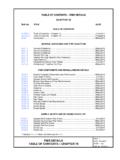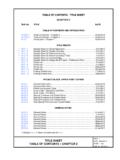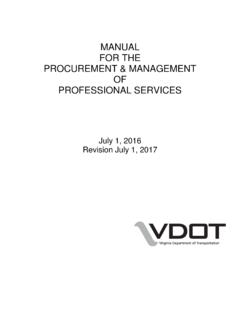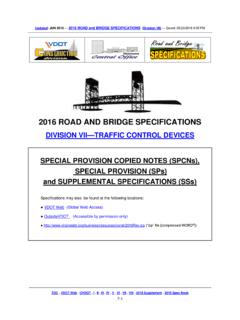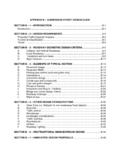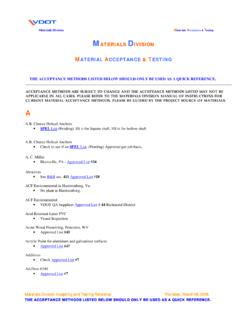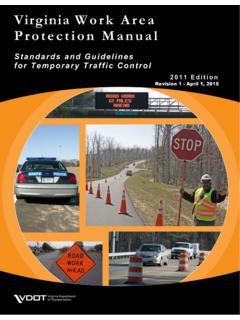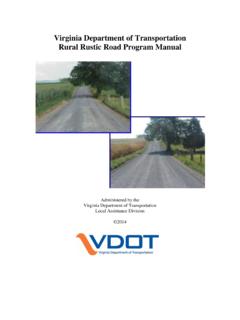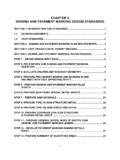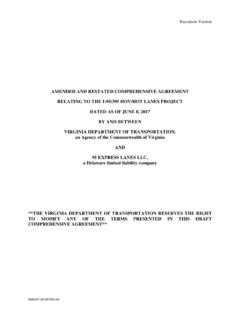Transcription of Waste Management and Pollution Prevention Guide 2013
1 VIRGINIA DEPARTMENT OF TRANSPORTATION. Waste Management AND. Pollution Prevention . Guide . JANUARY, 2015. MS4 / Waste Management Pollution Prevent Guide (WMPPG) CROSSWALK. MS4 No. Permit Requirement Corresponding VDOT Requirement and Guide MS4 1 Ensure proper disposal of Waste , including Waste Management Guides , landscape , , , , , , , , , , , , , , , , , , , and , MS4 2 Prevent the discharge of vehicle wash water Waste Management Guides and MS4 3 Prevent the discharge of wastewater Waste Management Guide MS4 4 Minimize discharge of pollutants from bulk storage Waste Management Guides , , , and MS4 5 Prevent discharge from leaking vehicles and Waste Management Guides equipment and Require implementation of BMP during utility ESC Standards & Specifications construction and maintenance activities Prevent illicit discharges IDDE Manual Ensure proper application of pesticides and DACS certification and nutrient fertilizers Management plan The MS4/WMPPG Crosswalk chart provides a general overview of Specific MS4 Permit requirements and the associated WMPP Guides that can be used to assist with compliance with the requirement.
2 As reflected in the chart, a generic MS4 Number has been assigned to the permit requirement that have an associated Waste Management Guide . The corresponding guides are listed in the third column. Likewise as an additional compliance aid, within the Table of Contents on the following page, the MS4 Number is also listed next to each Guide Number. Environmental Hazmat Team Site The Hazardous Materials Section of the Environmental Division maintain a team site where all the Guides presented in this document are maintained and updated as needed. The Team Site can be accessed at the following link: Table of Contents Section 1 Soild and Hazardous Waste Overview Guide Soild Waste Guide Hazardous Waste Section 2 Hazardous Waste Management and Generator Status Categories Guide Satellite Accumulation Guide Conditionally Exempt Small Quantity Generators (CESQG).
3 Guide Small Quantity Generators (SQG). Guide Large Quantity Generators (LQG). Section 3 Waste Management Guide Aerosol Cans MS4-1. Guide Animal Carcasses MS4-1. Guide Antifreeze MS4-1. Guide Asphalt Equipment Cleaning MS4-1. Guide Batteries MS4-1. Guide Bridge Timbers and Treated Lumber MS4-1. Guide Empty Containers MS4-1. Guide E- Waste (Monitors, Computers, Etc.) MS4-1. Guide Filters Oil, Gas, Diesel, Paint MS4-1. Guide Fluorescent Lamps, HID, and Metal Halide MS4-1. Guide Freon MS4-1. Guide Herbicides and Pesticides MS4-1. Guide Light Ballasts (PCB and non-PCB) MS4-1. Guide Mercury Switch and Equipment MS4-1. Guide Oil, Gas and Diesel Waste MS4-1. Guide Paint Waste Latex and Solvent Based MS4-1. Guide Parts Cleaners MS4-1. Guide Rags, Wipes, Absorbents MS4-1. Guide Scrap Tires MS4-1.
4 Guide Salt Infrastructure and Waste Management MS4-1. Guide Salt Spreaders MS4-1. Guide Solid Waste (Trash) MS4-1. Guide Fuel Water Mixtures MS4-1. Guide Vehicle Wash Pads MS4-2. Guide Soil, Concrete, Asphalt MS4-1. Section 4 Pollution Prevention and Other Hazmat Program Information Guide Hazardous Materials Contracts and Disposal Contracts Guide Spill Prevention Controls and Countermeasures (SPCC) MS4-4 & 5. Guide Spill Response and Reporting MS4-5. Guide Oil-Water Separator (OWS)/Grit Chamber O and M MS4-2 & 3. Guide Non-SPCC Secondary Containment Operation MS4-4. Guide Erodible Materials Management MS4-4. Guide Street Sweeping/Vac-Truck Materials Management MS4-4. Guide Oil Drip / Equipment Leak Control and Cleanup MS4-5. Section 5 Training Guide Hazardous Waste Training Guide USDOT Hazardous Materials Shipping Training Guide SPCC Training Guide Universal Waste Training Guide MS4 Training Guide Illicit Discharge Detection and Illimination (IDDE) Training Waste Management / Pollution Prevention Guide Supplemental Appendices Appendix 1- VDOT/VDEQ Solid Waste MOA and Implementation Guidelines Appendix 2- Asphalt Equipment Cleaning Best Management Practices Appendix 3- Vehicle and Equipment Washing Pad Siting, Construction, and Maintenance Guide Appendix 4- Street Sweeping/Vac Truck Materials Management Pad Design and Use Guide Appendix 5- VDOT/VDEQ Animal Composting MOU and Implementation Guidelines Section 1.
5 Solid and Hazardous Waste Overview Guide Soild Waste It it simplest terms, the definition of solid Waste within the Virginia Solid Waste Management Regulations is any discarded material . The regulations then expand on this definition by providing 7 pages of exclusions and conditional exemptions. Solid Waste are further categorized as either Non-Hazardous Waste or Hazardous Waste , with Universal Waste being a subcategory of Hazardous Waste . For VDOT, solid wastes are basically trash and other debris that are generated during maintenance and other operations that are sent to a landfill for disposal. Certain materials that are recycled are exempt from the soild Waste regulation. The Management of Hazardous Waste is strictly controlled between the point of generation, on- site Management , transportation, and disposal.
6 Management of Hazardous Waste are described in detail in Guide and Guides through , as well as each specific Guide for wastes that may be required to be managed as a hazardous Waste . The following guides provide an overview proper Waste Management procedures and options for solid wastes, hazardous wastes and universal wastes generated during VDOT operations. Guide Hazardous Waste Revision 0. VDOT facility operations produce wastes. While some of these wastes may seem like ordinary trash, they may actually be regulated hazardous wastes. As such, the way they are handled, stored, and disposed of is strictly mandated by state and federal law and there are substantial fines and possible criminal penalties for violations of the requirements. Therefore, strict adherence to these procedures is important.
7 If you have any questions or need any assistance in classifying and properly managing hazardous wastes, please contact your Regional Hazardous Materials Manager or Central Office Hazardous Materials Section. While not necessarily comprehensive, the following list of VDOT operations has the potential to generate hazardous wastes: Facility maintenance activities Vehicle and Equipment maintenance and repair Parts cleaning Pavement marking Landscaping and vegetation control Materials analysis Traffic engineering Sign/Graphics shop Janitorial activities Spill cleanup Hazardous wastes can be solids, liquids or gases. Wastes (discarded materials) that have certain hazardous characteristics may be considered a hazardous Waste . These characteristics include: Ignitability: Ignitable Waste can readily catch fire and sustain combustion.
8 Waste materials with a flash point less than 140oF have the characteristic of ignitability (the MSDS or product label typically has flash point information). Examples include solvent-based paint wastes, thinners, mineral spirits, flammable aerosol cans, and certain degreasers. Corrosivity: Corrosive wastes are liquids that can readily corrode metal or dissolve flesh. Waste liquid materials with a pH between 2 and have the characteristic of corrosivity (the MSDS or product label typically has the pH information). Examples include rust removers, acid cleaners, alkaline cleaners, and Waste battery acid. Reactivity: Reactive Waste can explode, undergo a violent reaction, or produce certain gases. Examples include aerosol cans, certain metals, explosives, cyanide compounds or compounds with high sulfur content.
9 Toxicity: Toxic wastes are those that are harmful or fatal when ingested or absorbed, or toxic to the environment. This type of Waste can contain heavy metals or pesticides. Examples include mercury containing devices, pesticides, fluorescent light tubes, HID lamps, and computer monitors. In addition to these characteristics, some hazardous wastes may appear on one of four lists maintained by USEPA and are known to be harmful to human health or the environment when not managed properly. They are listed by a chemical name or by the process that generates them: F' list: Wastes generated from common industrial or manufacturing processes such as degreasing solvents and certain other solvents. Examples include trichloroethylene, acetone, and toluene. K' list: Wastes generated from specific industries such as chemical manufacturing and refineries.
10 VDOT does not generate any of these wastes. P' & U' list: Both lists are very similar. The wastes on these lists are pure or commercial grade formulations of toxic chemicals that are being discarded. Section 2. Hazardous Management and Generator Status Categories Guide Satellite Accumulation Revision 0. A person or activity that generates hazardous Waste may accumulate as much as 55 gallons of hazardous Waste or 1 quart of acutely toxic hazardous Waste in containers at or near the point of its generation without any storage time limits. This method of hazardous Waste storage allows for hazardous Waste to be temporarily and conveniently stored. This can be done without complying with the more stringent Small Quantity and Large Quantity storage requirements described in Guide and Keep the container closed during storage Clearly identify the contents of the container and include the words Satellite Accumulation'.
